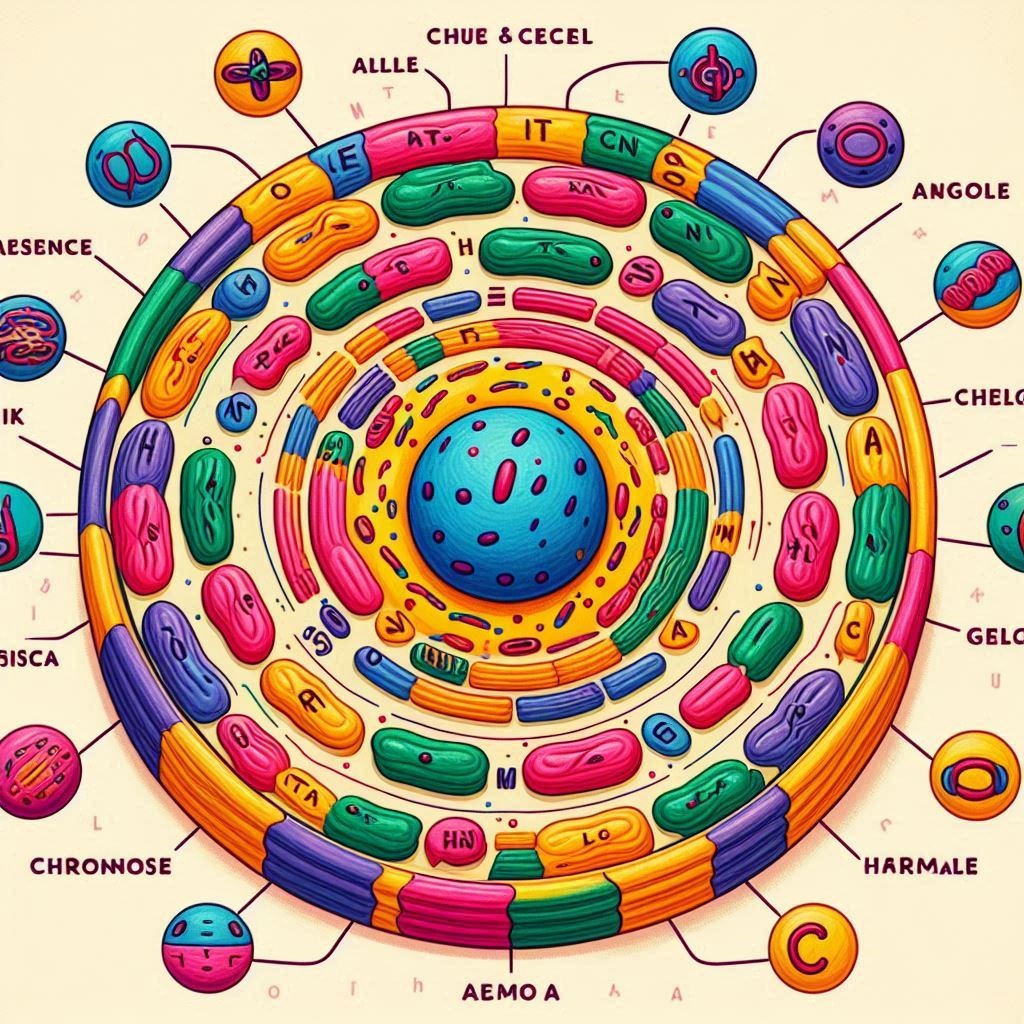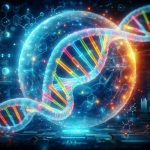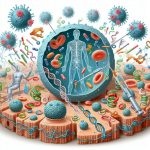Chromosome: The Blueprint of Life
Introduction to Chromosome
A chromosome is a long DNA molecule with part or all of the genetic material of an organism. Chromosomes are located in the nucleus of eukaryotic cells and play a crucial role in inheritance, cellular division, and the regulation of genes. For more detailed information on chromosomes, visit this Chromosome Wikipedia Page.
Types of Chromosomes
Chromosomes are classified into different types based on their structure and function. The two main types of chromosomes are autosomes and sex chromosomes. Autosomes determine the general traits of an organism, while sex chromosomes determine the sex. For additional details, check this Chromosome Glossary
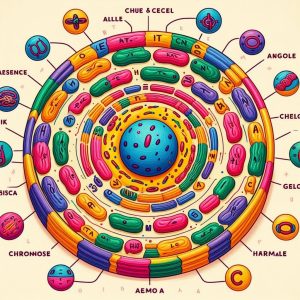
| Type | Description |
|---|---|
| Autosome | Any chromosome that is not a sex chromosome; humans have 22 pairs of autosomes. |
| Sex Chromosome | Chromosomes that determine the sex of an organism; humans have one pair of sex chromosomes (X and Y). |
Autosomes
Autosomes are chromosomes that do not determine the sex of an organism. They are numbered differently across species, but in humans, there are 22 pairs of autosomes. Each pair consists of one chromosome inherited from each parent. These chromosomes carry genes responsible for various traits and functions in the body. For more information, visit this Genome.gov Autosome Glossary.
| Type | Number in Humans | Function |
|---|---|---|
| Autosomes | 22 pairs (44 chromosomes) | Carry genes for various body traits and functions |
Autosomes are a critical component of our genetic makeup. They are the non-sex chromosomes that carry the majority of our genetic information. This article delves into the significance, structure, and function of autosomes, as well as their role in genetic disorders.
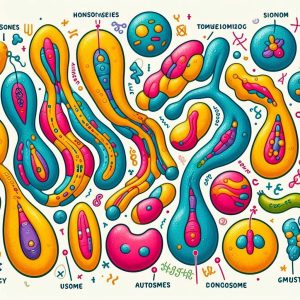
What are Autosomes?
Autosomes are chromosomes that are not directly involved in determining the sex of an individual. In humans, there are 22 pairs of autosomes, numbered from 1 to 22 based on their size and structure. These chromosomes carry genes that are responsible for various bodily functions and characteristics.
Difference Between Autosomes and Sex Chromosomes
While autosomes are involved in most of our genetic traits, sex chromosomes (X and Y) determine an individual’s sex. Humans have 23 pairs of chromosomes in total, with the 23rd pair being the sex chromosomes. Autosomes are similar in both males and females, whereas the sex chromosomes differ (XX in females and XY in males).
Structure and Function of Autosomes
Each autosome is made up of DNA tightly coiled around proteins called histones. The DNA sequence on autosomes contains many genes, each of which codes for proteins essential for the body’s development, function, and maintenance.
Table: Overview of Human Autosomes
| Autosome Number | Approximate Length (base pairs) | Key Functions |
|---|---|---|
| 1 | 249 million | Contains genes involved in cell structure and function |
| 2 | 242 million | Includes genes related to sensory perception and immune response |
Role in Genetic Disorders
Mutations or alterations in autosomal genes can lead to a variety of genetic disorders. These include autosomal dominant disorders, where only one copy of the mutated gene is needed to cause the disease, and autosomal recessive disorders, where two copies of the mutated gene are necessary.
Examples of Autosomal Disorders
Some common autosomal disorders include:
- Cystic Fibrosis: An autosomal recessive disorder affecting the lungs and digestive system. Learn more about cystic fibrosis.
- Huntington’s Disease: An autosomal dominant disorder that causes progressive brain degeneration. Learn more about Huntington’s disease.
- Sickle Cell Anemia: An autosomal recessive disorder affecting red blood cells. Learn more about sickle cell anemia.
Research and Advances
Recent advances in genetics and genomics have significantly enhanced our understanding of autosomes. Techniques like CRISPR-Cas9 and whole-genome sequencing are being used to study and potentially correct genetic mutations on autosomes.
Picture Space
Insert relevant images or diagrams here to illustrate autosomal structure and genetic concepts.
Autosomes play a crucial role in our genetic inheritance and overall health. Understanding their structure, function, and impact on genetic disorders helps us appreciate the complexity of human biology and the potential for future medical breakthroughs.
Sex Chromosomes
Sex chromosomes determine the biological sex of an organism. In humans, there are two types of sex chromosomes: X and Y. Females typically have two X chromosomes (XX), while males have one X and one Y chromosome (XY). These chromosomes not only determine sex but also carry genes that affect other traits. For additional insights, refer to this NCBI Sex Chromosomes Page.
| Type | Number in Humans | Function |
|---|---|---|
| X Chromosome | 1 pair (2 chromosomes) | Determines female sex and carries genes affecting other traits |
| Y Chromosome | 1 (in males) | Determines male sex and carries genes affecting male-specific traits |
Chromosome Abnormalities
Abnormalities in the number or structure of chromosomes can lead to genetic disorders. Common types of chromosomal abnormalities include aneuploidy, deletions, duplications, and translocations. For more detailed information, visit this Mayo Clinic Chromosome Analysis Page.
Chromosome abnormalities are changes in the number or structure of chromosomes and can have significant impacts on an individual’s health and development. This article explores the causes, types, and implications of chromosome abnormalities, highlighting their importance in medical genetics.
What Are Chromosome Abnormalities?
Chromosome abnormalities refer to alterations in the normal number or structure of chromosomes. These abnormalities can lead to developmental delays, physical malformations, and a variety of genetic disorders. Chromosome abnormalities can be detected through genetic testing and are a key area of study in medical genetics.
Causes of Chromosome Abnormalities
Chromosome abnormalities can arise due to errors during cell division, environmental factors, or inherited genetic conditions. Some common causes include:
- Nondisjunction: Failure of chromosomes to separate properly during meiosis, leading to an abnormal number of chromosomes.
- Structural Changes: Breaks and rejoining of chromosome segments resulting in deletions, duplications, inversions, or translocations.
- Environmental Factors: Exposure to radiation, chemicals, or viruses that can damage chromosomes.
Types of Chromosome Abnormalities
Chromosome abnormalities can be classified into two main categories: numerical abnormalities and structural abnormalities.
Numerical Abnormalities
Numerical abnormalities involve a change in the number of chromosomes. Common examples include:
- Trisomy: Presence of an extra chromosome (e.g., Down syndrome, where there is an extra copy of chromosome 21).
- Monosomy: Absence of one chromosome (e.g., Turner syndrome, where there is only one X chromosome).
- Polyploidy: Presence of more than two sets of chromosomes, which is usually incompatible with life.
Table: Common Numerical Chromosome Abnormalities
| Syndrome | Chromosome Abnormality | Key Features |
|---|---|---|
| Down Syndrome | Trisomy 21 | Intellectual disability, distinct facial features |
| Turner Syndrome | Monosomy X | Short stature, infertility |
| Klinefelter Syndrome | XXY | Tall stature, infertility |
Structural Abnormalities
Structural abnormalities involve changes in the arrangement of chromosome segments. Examples include:
- Deletions: Loss of a chromosome segment, such as in Cri du Chat syndrome.
- Duplications: Extra copies of a chromosome segment, leading to conditions like Charcot-Marie-Tooth disease type 1A.
- Inversions: A chromosome segment breaks off, flips around, and reattaches, potentially disrupting gene function.
- Translocations: Segments from two different chromosomes are exchanged, as seen in some cancers.
Table: Examples of Structural Chromosome Abnormalities
| Condition | Chromosome Abnormality | Key Features |
|---|---|---|
| Cri du Chat Syndrome | Deletion on chromosome 5 | High-pitched cry, intellectual disability |
| Charcot-Marie-Tooth Disease Type 1A | Duplication on chromosome 17 | Peripheral neuropathy, muscle weakness |
| Chronic Myelogenous Leukemia (CML) | Translocation between chromosomes 9 and 22 | Abnormal white blood cells, fatigue |
Implications and Diagnosis
Chromosome abnormalities can lead to a wide range of health issues, from mild to severe. Early diagnosis through genetic testing, such as karyotyping or chromosomal microarray analysis, is crucial for managing and understanding these conditions.
Picture Space
Insert relevant images or diagrams here to illustrate chromosome abnormalities and their effects.
Understanding chromosome abnormalities is essential for diagnosing and treating genetic disorders. Advances in genetic research and technology continue to improve our ability to detect and manage these abnormalities, offering hope for affected individuals and their families.
Chromosomal Function and Importance
Chromosomes play a crucial role in the proper functioning of cells and the inheritance of genetic traits. They ensure that DNA is accurately replicated and distributed during cell division. For further reading on chromosome functions, visit this Nature Scitable Page.
| Type | Description |
|---|---|
| Autosome | Any chromosome that is not a sex chromosome; humans have 22 pairs of autosomes. |
| Sex Chromosome | Chromosomes that determine the sex of an organism; humans have one pair of sex chromosomes (X and Y). |
Structure of Chromosomes
The structure of a chromosome is complex, comprising DNA wrapped around histone proteins to form nucleosomes, which further coil to form a chromatin fiber. The chromatin fibers condense to form the familiar X-shaped structure of a chromosome during cell division. Detailed insights can be found on this Nature Scitable Page.
Functions of Chromosomes
Chromosomes have several essential functions including carrying genetic information, ensuring accurate DNA replication and distribution during cell division, and regulating gene expression. For more on these functions, visit this NCBI Bookshelf Page.
Functions of Chromosomes
Chromosomes have several key functions that are vital for the growth, development, and maintenance of organisms. These functions include:
1. Genetic Information Storage
Chromosomes store genetic information in the form of DNA sequences. This information is essential for the production of proteins and the regulation of cellular activities. The structure of chromosomes ensures that this information is organized and accessible.
2. Gene Expression Regulation
Chromosomes play a crucial role in the regulation of gene expression. Regulatory elements within chromosomes control when, where, and how much of each gene is expressed. This precise regulation is necessary for proper cell function and organismal development.
3. DNA Replication
During cell division, chromosomes ensure that DNA is accurately replicated and distributed to daughter cells. This process is vital for growth, repair, and reproduction. Each chromosome is duplicated during the S phase of the cell cycle, resulting in two identical sister chromatids that are separated during mitosis or meiosis.
4. Genetic Diversity
Meiosis, the process of producing gametes, involves the recombination and independent assortment of chromosomes. This genetic shuffling creates genetic diversity within a population, which is essential for evolution and adaptation.
Table: Key Functions of Chromosomes
| Function | Description | Importance |
|---|---|---|
| Storage of Genetic Information | Contains DNA sequences that encode proteins and regulate cell activities | Essential for the organism’s structure and function |
| Gene Expression Regulation | Controls when and how genes are expressed | Ensures proper development and cellular function |
| DNA Replication | Accurately copies and distributes DNA during cell division | Crucial for growth, repair, and reproduction |
| Genetic Diversity | Creates variation through recombination and independent assortment | Important for evolution and adaptation |
Importance of Chromosomes in Health and Disease
Chromosomes are critical for maintaining genetic stability. Any changes or mutations in the chromosomal structure can lead to various genetic disorders and diseases.
Genetic Disorders
Chromosomal abnormalities can result in a range of genetic disorders, including Down syndrome, Turner syndrome, and Klinefelter syndrome. These conditions arise from changes in chromosome number or structure and can affect physical and intellectual development.
Cancer
Many cancers are associated with chromosomal abnormalities, such as translocations, deletions, and amplifications. For example, chronic myelogenous leukemia (CML) is linked to the Philadelphia chromosome, a result of translocation between chromosomes 9 and 22.
Genetic Counseling
Understanding chromosomal function and abnormalities is essential for genetic counseling. Genetic counselors use this knowledge to assess the risk of inherited conditions, guide diagnostic testing, and provide information to affected individuals and families.
Chromosomes are indispensable to the biological functions of all living organisms. Their roles in genetic information storage, gene expression regulation, DNA replication, and genetic diversity are fundamental to life. Understanding chromosome function and importance is crucial for advancing medical research, diagnosing genetic disorders, and improving health outcomes.
Human Chromosomes
Humans have 46 chromosomes, arranged in 23 pairs. Each pair consists of one chromosome inherited from the mother and one from the father. These chromosomes contain all the genetic instructions necessary for the development and functioning of the human body. For further reading, check this Genetics Home Reference.
| Chromosome Pair | Function |
|---|---|
| 1-22 (Autosomes) | Determine various traits such as eye color, hair color, height, etc. |
| 23 (Sex Chromosomes) | Determine the sex of the individual; XX for females and XY for males. |
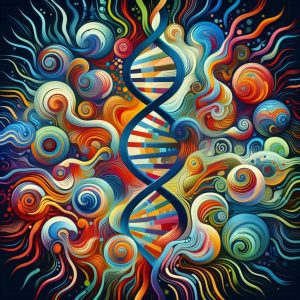
Chromosomal Disorders
Abnormalities in chromosomes can lead to various genetic disorders. Some common chromosomal disorders include Down syndrome, Klinefelter syndrome, and Turner syndrome. These disorders result from missing, extra, or abnormal arrangement of chromosomes. For more information, visit this Mayo Clinic Page.
Advancements in Chromosome Research
Recent advancements in genetic engineering, such as CRISPR-Cas9, have enabled scientists to edit chromosomes with precision, opening new possibilities for treating genetic disorders and understanding complex genetic mechanisms. Learn more on this GenomeWeb Article.
Conclusion
Understanding chromosomes is fundamental to the fields of genetics, medicine, and biology. As research progresses, the potential for breakthroughs in diagnosing, treating, and preventing genetic disorders grows. For continued updates, visit this Nature Chromosomes Page.

